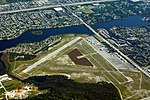John Prince Memorial Park
John Prince Memorial Park is a park located in Lake Worth Beach, Florida. The park covers 726.36 acres (338 of which are acres of Lake Osborne) and is managed by the Palm Beach County Parks and Recreation Department. Most of the park is on the western and northern shore of Lake Osborne. Some of the facilities at the park include: a new five section dog park called Lake Woof, pavilions, park ground structures, tennis courts, basketball courts, volleyball courts, boat/canoe/kayak launch, outdoor fitness center, and a campground. The park is located adjacent to the Lantana Airport. The park is named after former county commissioner John Prince who served for 18 years. Mr. Prince got developers and the state to donate more than 1,000 acres (4.0 km2) of land in the 1930s and 1940s which became the park, Palm Beach State College's Lake Worth campus and the Lantana Airport. John Prince Park is believed to be the second oldest county park in Florida.
Excerpt from the Wikipedia article John Prince Memorial Park (License: CC BY-SA 3.0, Authors).John Prince Memorial Park
Geographical coordinates (GPS) Address Nearby Places Show on map
Geographical coordinates (GPS)
| Latitude | Longitude |
|---|---|
| N 26.604330555556 ° | E -80.089033333333 ° |
Address
33461
Florida, United States
Open on Google Maps





